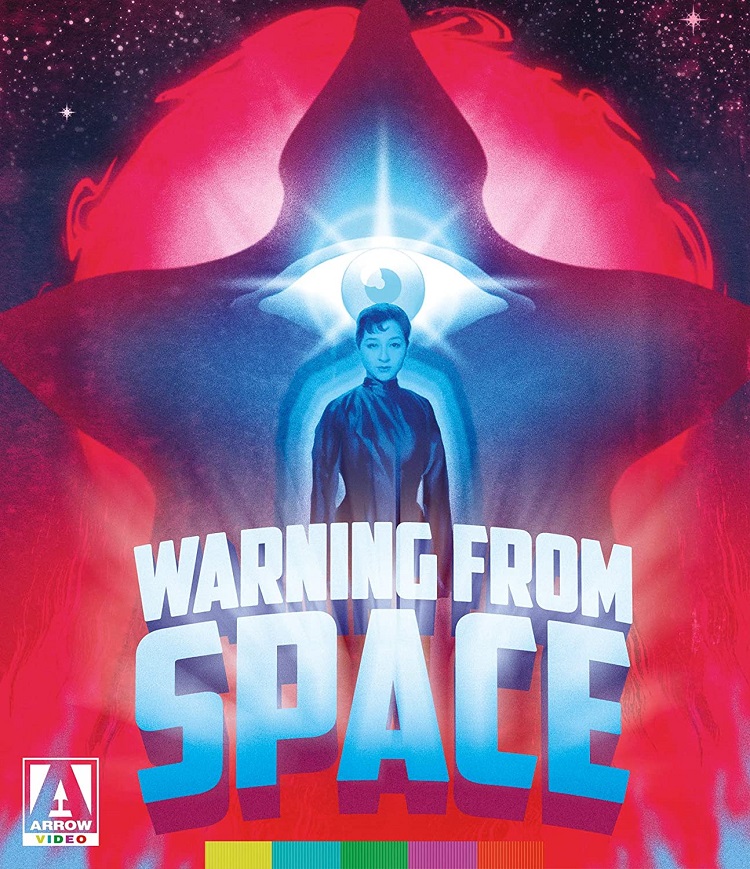
All science fiction is dated. Even the most up-to-the-minute, forward-looking piece of work is still a work of its time, and time passes. An old science fiction movie is going to look old. The special effects aren’t going to look contemporary. The science will not be up to date. The way things work in the story are not the way things actually happen. So how, in the spirit of open-hearted appreciation, can a modern viewer approach something like Warning from Space, released in 1956?
The premise isn’t going to be new to anyone with a cursory knowledge of even the least literary of science fiction films – aliens are coming to earth, the planet is in mortal danger, that kind of thing. In Warning From Space, UFOs are spotted above Tokyo, and days later strange alien beings are spotted throughout the city. Who are they? Why are they here? Well, look at the title of the film, that should give you a clue. These aliens come with…a Warning from Space.
And that warning is that an enormous object, a rogue planet, is right now hurtling towards Earth, and in order to protect themselves the countries of Earth will have to band together and lob all of their existing nuclear arsenal at the planet, in some hope of breaking it up before it rains its destruction down on them. This is good old ’50s sci-fi, which means much of the action involves men in lab coats looking very seriously through telescopes, or microscopes, furrowing their brows and discussing with other men in lab coats about how to solve this insoluble problem.
Warning from Space takes a number of different approaches as it tells a story of surprising scope. It builds slowly, with the phenomenon of the UFOs being dismissed by the scientific experts until photographic proof is brought to bear. Then the appearances of the aliens are handled like something from a horror movie, appearing in the dark or emerging from the water and terrifying the locals.
I found these scenes to all be quite effectively handled, thanks largely to the bizarre design of the creatures themselves. Designed by Japanese avant-garde artist Taro Okamoto, the alien are starfish shaped with a giant central eye and no faces. Rising up from the deeps or seen looking into houses from the dark, they’re genuinely odd and off putting…until there’s a central scene with the entire set of the aliens standing in their ships and having a conversation. This makes it very clear that this is just a group of guys wearing five-pointed cloth bags with eyes sewn in the middle. It’s far from seamless but as that scene went on, I found myself feeling less smug about how goofy it looked at being drawn into the oddness and earnestness of it all. It doesn’t look real, but it does look cool.
And that’s a surprising thing about Warning from Space, especially if one has only seen it before in the English-dubbed version that was routinely available on TV for years, and is still around on YouTube in horribly washed-out, pixelated versions. This was an extremely well-shot film; the first Japanese sci-fi movie to be made in color, which it uses superbly. The scenes take place on well-built and appointed sets; it’s a good looking film. As disaster approaches, there are well-staged scenes of the destruction of Tokyo that will warm the heart of any Godzilla fan, or anyone who likes to watch scale models blow up.
Its storytelling style and scope doesn’t lend to deep characterization, and the people populating the film are mainly stock types: scientists, news men, the girl, the hero who is just another scientist and who doesn’t actually do anything heroic. At one point it’s not him, but one of the old scientists who ends up being kidnapped by industrial spies who want the formula for a new power source he’s developed – a formula whose creation is opposed by the aliens who came with the warning.
But it all plays out on an impressively broad canvas, at a quick pace, and with enough touches of quirkiness and humanity that elevate it about a formulaic ’50s sci-fi movie. Whether that’s enough for a casual audience to want to add the film to their library is debatable. As much as I was charmed by aspects of the film, and appreciated the fine production value, I couldn’t say I was deeply involved in the story. The aliens, so much a focus of the beginning of the film, essentially disappear for a good third of the movie. And while the storyline is thoughtful, the plot isn’t completely cohesive. It’s a fun old film, but it’s just as old as it is fun.
Warning from Space has been released on Blu-ray by Arrow Video. This release has a restored high-definition transfer of the film, which mostly looks great (taking its age into consideration) though there are scenes that have some flickering and color fluctuations. There are two versions of the film included: the original Japanese version, and the English-dubbed version released in 1963, here reconstructed largely using the new HD transfer of the Japanese version. Other extras on disc include a select-scene commentary by Japanese film expert Stuart Gailbraith IV. The included booklet contains essays “Taro Okamoto” by Nick West, and on the creation of the English-dubbed version by David Cairns.